38M Toldi
This article includes a list of general references, but it remains largely unverified because it lacks sufficient corresponding inline citations. (November 2010) |
| 38M Toldi | |
|---|---|
 38M Toldi I command tank with radio antenna | |
| Type | Light tank |
| Place of origin | Kingdom of Hungary |
| Service history | |
| In service | 1939-1945 |
| Used by | |
| Wars | World War II |
| Production history | |
| Designer | AB Landsverk, MÁVAG |
| Designed | 1936-38 |
| Manufacturer | MÁVAG, Ganz Works |
| Produced | 1939–1942 |
| No. built | 202 |
| Variants | Toldi I, Toldi II, Toldi IIA, Toldi III |
| Specifications | |
| Mass | Toldi I: 8.5 t Toldi IIA: 9.3 t |
| Length | 4.75 m (15 ft 7 in) |
| Width | 2.14 m (7 ft 0 in) |
| Height | 1.87 m (6 ft 2 in) |
| Crew | 3 |
| Armor | Toldi I: 7-13 mm Toldi II: 7-23 mm Toldi III: 7-35 mm |
Main armament | 20 mm Solothurn S-18/100 gun[a] (Toldi I/II) 37/42M 40 mm L/42,5 or L/45 gun (Toldi IIA/III) |
Secondary armament | 1x 8 mm (0.31 in) Gebauer machine gun |
| Engine | Büssing-NAG L8V 7.9 litres 155-160 bhp |
| Power/weight | 19 hp/t |
| Suspension | torsion bar |
Operational range | 200 km (120 mi) |
| Maximum speed | 50 km/h (31 mph) on road |
Steering system | clutch braking |
The 38M Toldi was a Hungarian light tank, developed on the basis of the Swedish Landsverk L-60. It was named after the 14th century Hungarian knight Miklós Toldi.
Development and production[]
The Hungarian general staff wanted a modern light tank as soon as possible, after the domestically developed V-4 turned out to be too expensive by 1936 and work on it progressed slower than expected.[1]
Meanwhile, the Swedish AB Landsverk finished its recent development, the Landsverk L-60 in October, and was looking for a customer to cover the costs. After a series of trials in 1937 with the V-4 and the Panzer I, the MÁVAG heavy industries decided to purchase the license of the L-60, with a prototype for further development.[2][unreliable source?]
The turret of the vehicle was then modified, making space for the radio and other devices, with a cupola being placed on top (since the L-60 was still unfinished and lacked in many necessary features).[2] The original main armament, the 20 mm Madsen was also replaced initially by a 25 mm Bofors autocannon, and then by the 20 mm Solothurn anti-tank rifle, as it was already in service in the Hungarian army.[3] The hull would then be changed on the front, upper sides, and rear, to riveted plates instead of welded for faster and easier production, with the original Scania-Vabis 1664 engine being replaced by the German Büssing L8V.[4]
At first, 80 vehicles were ordered from MÁVAG, then an order for 110 more vehicles were placed in 1940.[4] In total, 202 units were produced.
Variants[]
- 38M Toldi I (A20) - first variant armed with a 20 mm Solothurn anti-tank rifle,[5] 80 made.
- 42M Toldi II (B20) - variant with thicker front armour, 110 made.
- 42M Toldi IIA (B40) - modification developed in 1942, armed with the 37/42M 40 mm gun and a larger turret - 80 tanks of earlier variant were rearmed this way.
- 43M Toldi III (C40) - improved variant with thicker armor and schürzen plates. Only 12 made.
- 43M Toldi Páncélvadász ('Toldi tank destroyer') - Toldi hull with a German 7.5 cm Pak 40 anti-tank gun in an open casemate. Only 1 prototype made.[6]
Combat[]
The Toldi tanks first saw action with the Hungarian Army in the 1941 invasion of Yugoslavia .[4] These tanks were then mostly used against the USSR between 1941 and 1944. Because of their light armour, armament and good communications equipment, they were mostly used for reconnaissance. The design was effective against Soviet light tanks widespread during the early stages of Operation Barbarossa, such as the obsolete T-26 and BT-5. However it was totally inadequate against the Soviet T-34 medium tanks encountered during the later stages of the war on the Eastern Front.
Service history[]
The Toldi entered Hungarian service in 1940. From 1942, the Toldi's were reassigned to reconnaissance, command and ambulance roles. [4]
Several Toldi tanks were captured by the USSR late in the war, two of them were transported to Kubinka for testing and are still preserved there.[2]
A few Toldis were captured by the Romanians after the 1944 coup d'etat removed the Axis-aligned government. Their further fate is unknown.[7]
Survivors[]
Two known surviving 38M Toldi tanks (one Toldi I and one Toldi IIA) are preserved on display at the Kubinka Tank Museum.
Notes[]
- ^ known as '36M 20mm Nehézpuska'
References[]
- ^ "Hadmérnök XIII/2. 2018. jún" (PDF).
- ^ a b c "Magyar Harckocsik a II. Világháborúban". War Thunder - Official Forum (in Hungarian). Retrieved 2021-10-12.
- ^ "38M "Toldi"". elfnet.hu. Retrieved 2021-10-12.
- ^ a b c d MarkoPantelic (2020-11-21). "Toldi I and II". tanks-encyclopedia.com. Retrieved 2021-10-12.
- ^ Zaloga, Steven J. (2018). The Anti-Tank Rifle. Oxford, UK: Osprey Publishing. p. 22. ISBN 978-1-4728-1722-8.
- ^ "Toldi tank destroyer". tanks-encyclopedia.com. Retrieved 2021-01-25.
- ^ Axworthy, Mark (1995). Third Axis, Fourth Ally: Romanian Armed Forces in the European War, 1941–1945. London: Arms and Armour. p. 221. ISBN 9781854092670.
External links[]
| Wikimedia Commons has media related to Toldi (tank). |
- Light tanks of Hungary
- World War II light tanks
- Armoured fighting vehicles of Hungary
- Military vehicles introduced in the 1930s